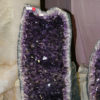calsfoundation@cals.org
Tripoli Mining
Tripoli is a microcrystalline form of quartz (SiO2) that is derived by the alteration of chert, chalcedony, or novaculite, or leaching of highly siliceous limestones. The removal of carbonate is essential to the formation of Arkansas tripoli. Tripoli is present in three general areas of Arkansas: northwestern Arkansas near Rogers (Benton County), in the Ouachita Mountains near Hot Springs (Garland County), and near Athens (Howard County).
Tripoli has varied uses. Due to its inert nature and its fine-grained texture, tripoli has numerous applications, mainly as an abrasive in polishing, buffing, and burnishing compounds; in scouring soaps and powders; a filler or extender in plastics, rubber, and sealants like caulks and epoxy resins; and a pigment in paints. It also improves the coating and flow of paints. As an additive in Portland cement, it enhances the product’s strength and washability. Firing tests on tripoli blocks have shown its potential as a high-quality lightweight aggregate.
The deposits of northwestern Arkansas were formed by the weathering of cherty limestones of the Boone Formation (Mississippian), while the Ouachita Mountains deposits were formed by the leaching of a limy phase within the Upper Division of the Arkansas Novaculite (Mississippian). Originally, portions of the Upper Division contained as much as thirty percent carbonate. Tripolitic zones in the Bigfork Chert (Ordovician) in western Saline County were investigated for commercial potential in the late 1990s and began being mined.
The category of tripoli, as broadly defined, is composed of extremely fine-grained crystalline silica in various stages of aggregation. The particle sizes usually range from one to ten micrometers, but particles as small as 0.1 to 0.2 micrometers are common. Analyses of Arkansas tripoli reveal that silica content is greater than ninety-nine percent. A typical analysis of processed tripoli from Arkansas novaculite is 99.49 percent SiO2, 0.015 percent TiO2, 0.102 percent Al2O3, 0.039 percent Fe2O3, 0.021 percent MgO, and 0.014 percent CaO, for a total of 99.68 percent. Although all three areas have been mined, only one combined mine and processing facility is active, as of 2011. Malvern Minerals Company of Hot Springs markets its products under registered trade names. Tripoli has been mined by both underground (Ozark region) and open-pit (Ouachita region) methods. The mined material is dried, crushed, pulverized, disaggregated, and sized by screening or air-flotation. The range of particle size of individual quartz grains composing tripoli is from 0.5 to 10 microns and equidimensional. The color of the tripoli varies within the same deposit. Colors include white, cream, tan, and brown, with white being the least prevalent but most marketable.
The early production of tripoli was from deposits in northwest Arkansas, beginning in 1929, with production recorded continuously through 1949. The total of that early production was estimated at 35,000 tons, valued at $500,000. Most production was from horizontal drifts driven into hillsides. No production from resources within the weathered Boone Chert (Mississippian) has occurred since that time. From 1960 to 1966, deposits within Montgomery and Pike counties were mined, producing an estimated 28,000 tons. More recent mining of tripoli has been from Garland and Saline counties by open-pit methods. Accurate data on production in recent years has been withheld by the U.S. Geological Survey and included in the total production of silica stone (novaculite) and industrial sand.
The mined output of tripoli is estimated at about 15,000 short tons per year. In 2007, Arkansas ranked third in the nation out of four producing states. Reserves of higher-grade white tripoli are limited, but other color grades are several million tons. Malvern Minerals is responsible for all of Arkansas’s recent production.
For additional information:
Holbrook, D. F., and Stone C. G. “Arkansas Novaculite—A Silica Resource.” In Thirteenth Annual Forum on the Geology of Industrial Minerals, edited by K. S. Johnson and J. A. Russell. Oklahoma Geological Survey Circular 79. Norman: Oklahoma Geological Survey, 1978.
“Industrial Minerals.” Arkansas Geological Survey. https://www.geology.arkansas.gov/minerals/industrial.html (accessed February 8, 2022).
Keller, W. D., C. G. Stone, and A. L. Hoersch. “Textures of Paleozoic Chert and Novaculite in the Ouachita Mountains of Arkansas and Oklahoma and Their Geological Significance.” Geological Society of America Bulletin 96 (1985): 1353–1363.
Steuart, C. T., D. F. Holbrook, and C. G. Stone. “Arkansas Novaculite: Indians, Whetstones, Plastics, and Beyond.” In Contributions to the Geology of Arkansas, vol. 2, edited by J. D. McFarland III and W. V. Bush. Arkansas Geological Commission Miscellaneous Publication 18-B. Little Rock: Arkansas Geological Commission, 1984.
J. M. Howard
Mabelvale, Arkansas
 Quartz Mining
Quartz Mining




Comments
No comments on this entry yet.